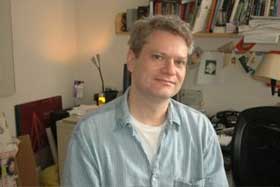 I subscribe to the feed of several del.icio.us tags such as tangible_computing, physical_computing and you know how this works, if a webpage or a person is regarded as particularly interesting ressource, they get tagged again and again, that’s how i get to read the name of Tom Igoe every week. Igoe is Area Head for physical computing classes at Interactive Telecommunications Program, New York University. His courses invite students to explore ways to allow digital technologies to sense and respond to a wider range of human physical expression and i’ve blogged dozens of projects that come right from his courses. Tom Igoe’s background is in theatre, and his work today centers on physical interaction related to live performance and public space. Along with Dan O’Sullivan, he co-authored “Physical Computing: Sensing and Controlling the Physical World with Computers.â€? His own projects include an internet-aware player piano; a clock that reads emails (my favourite); and a series of interactive dioramas, created in collaboration with M.R. Petit. He has consulted for The American Museum of the Moving Image, EAR Studio, Diller + Scofidio Architects, Eos Orchestra, etc.
I subscribe to the feed of several del.icio.us tags such as tangible_computing, physical_computing and you know how this works, if a webpage or a person is regarded as particularly interesting ressource, they get tagged again and again, that’s how i get to read the name of Tom Igoe every week. Igoe is Area Head for physical computing classes at Interactive Telecommunications Program, New York University. His courses invite students to explore ways to allow digital technologies to sense and respond to a wider range of human physical expression and i’ve blogged dozens of projects that come right from his courses. Tom Igoe’s background is in theatre, and his work today centers on physical interaction related to live performance and public space. Along with Dan O’Sullivan, he co-authored “Physical Computing: Sensing and Controlling the Physical World with Computers.â€? His own projects include an internet-aware player piano; a clock that reads emails (my favourite); and a series of interactive dioramas, created in collaboration with M.R. Petit. He has consulted for The American Museum of the Moving Image, EAR Studio, Diller + Scofidio Architects, Eos Orchestra, etc.
What is your background? do you regard yourself more as an engineer or an artist?
Neither. Before I came to New York, I was working in Boston as a lighting technician at a theatre there. My undergrad degree’s in theatre, and I focused on lighting design. I can’t really claim to be a designer either, but I think that the work I find most interesting tends to come from people who call themselves designers.
You’re Area head for physical computing classes at ITP. Do first year students arrive with notions of it already? How do you introduce them to it? with books? hands-on activities?
Nowdays, more and more of them are coming in with a notion of what physical computing is about, partially because we’ve made it a part of our core curriculum, and it’s one of the things we promote as one of our strengths when people come to visit the school. There are a few people who skip past the intro to physical computing class because they’ve got extensive experience in electronics, programming, and product or interaction design, but most incoming students still want to take the intro classes.
The intro to physical computing class is very hands-on. From day one, we have them building stuff. In fact, that’s a central part of the whole ITP approach, that you learn best by doing, by applying new skills to projects that you care about. In our classes, the other instructors and I talk about physical interaction design and try to give examples of work that illustrates our ideals, and we show them how to build basic circuits and some basic programming techniques. Students show projects they’ve made and ones they’re working on, and we talk about those.
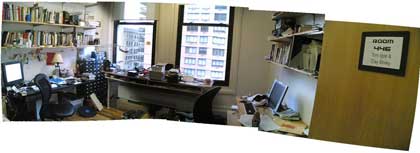 Tom’s office at ITP
Tom’s office at ITP
Do you advise your students to let their ideas run wild and then see how the technology available can best deal with their concept (meaning that their idea might have to be “dumbed down”) or should they start with what the technology offers?
Ideally the former, because the application should drive the technology. It’s never that simple, however. Sometimes a new technology suggests an application that wasn’t possible before, and sometimes a technology is developed for one purpose, but lends itself well to secondary applications. I think the best people in this area are both developing new ideas independent of technology and continually keeping abreast of new tools that might solve problems that they’ve had on the back burner for awhile.
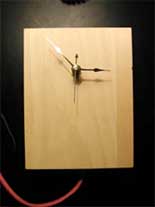
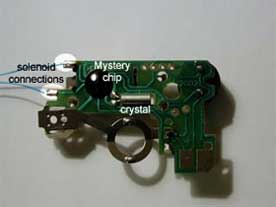 The Email Clock
The Email Clock
Do you follow the activities of your ex-students? How many of them manage to live (more or less) from their art? what other paths are available for them after graduation?
I follow as many of them as possible. Many of them continue to develop and show their own artwork, though I can’t say for sure what part of their income derives from it. I’ve seen a handful lately end up with residencies and fellowships to continue their art work, and I’m pleased to see it. In general, I advise students not to think of their careers in such a cut-and-dried way, however. Very few people are “pure” artists, and in general, I find the work of those who are less interesting than those who work at both art and design and commercial work. I think you learn so much from working for and with others that strengthens your artwork that you’d be a fool not to collaborate or work for others from time to time, at least.
As for other paths, there are many options. One of the most popular paths lately has been to look for exhibit design firms to work for. I think many students look for that kind of work because they see their professors doing it, and because it looks like comfortable commercial work (though folks doing it will tell you otherwise). Other students have gone on to pursue their thesis projects as commercial or not-for-profit ventures, either toys or assistive pr physical therapy devices. Some end up working for major tech companies in areas like mobile device applications or new products. A handful have gone into applications research. Some have gone on to teach. Most pursue two or more of these avenues at the same time. I think the most successful ITP alums take an entrepreneurial approach to their careers, whether it’s seeking new opportunities in large companies, starting their own businesses, seeking ways of getting their artwork shown, or a combination of all of those things.
I should also add that I’m not necessarily interested in creating “physical computing experts” through the phys comp program at ITP. The reason we offer the course as a core course is that we believe that physical action is a core part of interaction design, and even if you never touch hardware again after the intro class (and many don’t), there is something for you to learn from spending a period thinking about how the body meets the bits. I can think of many former students of whom I’m extremely proud who hated physical computing. I’m proud of them because they figured out what they really were interested in, and found ways to make a career of it. And I’ve seen many of them apply the troubleshooting skills they learned in my intro class and others, to a variety of problems. That’s what it’s really all about, for me.
Can you give us 3 examples of works that best embody what physical computing is? and why?
A lot of works that get cited as good physical computing tend to incorporate spectacular or elegant physical output, but for my money, those aren’t the really special ones. The ones that impress me most have really rich input. That’s the really hard part about physical computing, and the part that differentiates it from robotics, kinetic art, and other microcontroller-driven fields.
Dance Revolution would be high on my list. Not surprisingly, I see a lot of students try to emulate it in their work. The thing that’s so great about it is that the sensing system is very simple, as is the interface, but the game is so engaging. I’ve seen people play it in all kinds of different ways, from the beginner following along ploddingly while watching the screen, to expert players doing spins, leaps, using their hands as well as their feet, all kinds of things. They did a great job combining good sensing with good audiovisual cues and an easily understandable activity in that game. So well done!
It’s hard to talk about physical computing and not talk about Durrell Bishop‘s marble answering machine. I really love the way he used the marbles as both mnemonic triggers and tangible controls. He took something we all do every day — using physical items as memory triggers — and combined it with a well-known everyday device in a very elegant way. His work is humble, he makes devices you don’t take notice of when you’re using them, but that are pleasurable to use and to have. That’s so impressive to me.
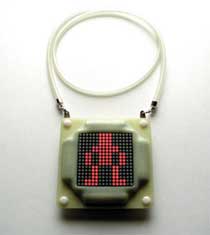 I like a lot of Maywa Denki‘s musical instruments as phys comp examples, because they’re so interesting and weird. In fact, the whole area of instrument design is a rich area for physical computing projects. But my favorite Maywa Denki piece is not an instrument, it’s the Bitman toy. It’s just an animation of a stick figure on an LED panel. There’s a tilt sensor in the panel, and as you tilt the panel, the figure climbs from one side to the next, trying to stay level. I love the way it moves, it’s so responsive to the movement of the whole panel.
I like a lot of Maywa Denki‘s musical instruments as phys comp examples, because they’re so interesting and weird. In fact, the whole area of instrument design is a rich area for physical computing projects. But my favorite Maywa Denki piece is not an instrument, it’s the Bitman toy. It’s just an animation of a stick figure on an LED panel. There’s a tilt sensor in the panel, and as you tilt the panel, the figure climbs from one side to the next, trying to stay level. I love the way it moves, it’s so responsive to the movement of the whole panel.
One of my favorite physical computing projects ever at ITP was done by a woman named Caren Rabbino. She wanted to illustrate the phantom limb phenomenon. She made a box with two holes into which you put your hands, face down. You could see your hands inside the box, but the border of the box obscured your forearms. One hole was slightly lower than the other, and the hand you saw above that hole was actually a mannequin hand. It was obvious to the eye that it was not your own hand. When you had your hands in, two feathers on servomotors were stroked across the real hand and the mannequin hand. Even though only one “real” hand was being stroked, you felt the feathers stroking both hands equally. It was amazing, and a wonderful way to demonstrate a phenomenon that really has to be experienced in order to understand it. The technology was so simple, just two servomotors and a switch, but it did the job beautifully.
What can artists bring to the development/discourse about physical computing?
I don’t think that art adds anything so important that artists deserve privilege over other disciplines. I do think that art training at its best gives people a heightened sensitivity to sensual cues (audio, visual, tactile, etc), and in some cases a strong ability to analyze work from an aesthetic perspective. That is valuable in this field. But it’s only part of the equation. You also need the creativity and attention to detail of a good engineer, the insight of a good social scientist, the pragmatism of a good business manager, and more. I think the people who do best in this field figure out very quickly that they can’t work alone, and that they need others to make a difference. They learn to leverage the skills of a group, to make the work stronger.
You’re also consulting for an impressive array of clients. Some are architects (Diller + Scofidio), others are museums (American Museum of the Moving Image), others are working on multi-media art (EAR Studio, Eos Orchestra). How do you manage to collaborate with people whose profiles are so different from each other? Is the dialog with them always easy? Is your role of a consultant always the same? What was your contribution to the Blur pavilion for example?
They’re not very different from each other, really. All of these projects is about display or performance, to me, so working with them is not that different from working on stuff in theatre. The questions are the same: what’s the feeling or atmosphere you’re looking to create? What space is it in? Who are the participants? What needs to happen in order to create what you’re looking for?
Is the dialog always easy? No. But then again, is there anyone who gets along with their clients or collaborators 100% of the time?
Is my role always the same? Sort of. On all the projects you mentioned, my role was to start with the bare idea and figure out ways that it could be implemented technologically. In some cases the project brief was very open and vague.
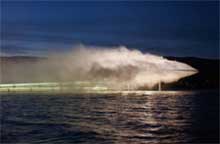
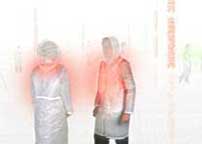 Blur
Blur
For example, on Blur, we went through many different ideas until we settled on the system we designed, and we went through many versions of that system. My role was to come up with production solutions for each version, and when we settled on one, to plan and budget it. The idea that we finally settled on was a set of interactive raincoats that lit up in different colors as people passed each other, the color depending on their affinity or antipathy to each other. The implementation had me researching various wearable lighting solutions and how they’d look in daytime fog; RF communications and RFID systems; realtime locating systems, and more. In the end, the interactive system never got built because of massive budget cuts to the project. So the major challenge there was cashflow.
On the Eos project, which was much smaller scale, I was working with two collaborators, David Bianciardi and Eric Singer, who were both excellent musicians and trained engineers, so my role was much more specialized. I just had to pick the easiest hardware components and sensors for us to work with and design the hardware. Eric took care of the software and music sequencing, and David oversaw all the logistics. But the idea was the same: given a desired event, what tools do we need to make it a reality?
What are you working on now?
A book on networked objects, and my syllabi for the upcoming fall semester at ITP (which had better be done by the time you publish this!).
I’m also teaching a new course this semester, a seminar on sustainability and technology. We ran a class like this earlier, taught by Jeff Feddersen, which was a great course, but for various reasons, we didn’t get to run it again. Now we want to build sustainability into the curriculum in a more permanent way. I’m really excited about it.
Anyone working in the field of physical computing whom you think should get more attention from the public?
Yeah, Mike Kuniavsky, Judith Zissman, and Elizabeth Goodman. They organized the best workshop that no one went to this summer, Sketching in Hardware. There were maybe 40, 50 people there tops, but a lot of really smart people who’d been thinking about and making tools for physical computing. The discussions that came out of there were really thought-provoking, and I’m hoping some of the collaborations will be as well.
I’m also interested in what Alexander Grunsteidl and Priya Prakash are up to at Digital Wellbeing Labs in London. Basically, they’re working on an interaction design lifestyle boutique, among other things. They’ve made the argument that interaction design work is uncomfortable in straight design stores, and equally misplaced in art galleries, and that it needs its own showcase, partly retail and partly development. They’ve picked a good range of work to support and sell, and I hope they succeed.
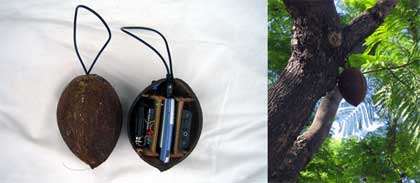
As far as physical computing artwork that’s impressed me lately, there’s one piece that I really liked, featured at ISEA this year: Tad Hirsch‘s Tripwire. He basically made sound sensing coconuts that he hung in the trees in San Jose, and each time the noise levels from planes exceeded the acceptable maximum, the coconuts called the city’s noise abatement complaint line. He’s done a number of really smart activist works like this that use humor tactically. The other thing that impressed me about this piece was that it was the one from the festival that made the most earnest attempt to try to address a real problem of the city hosting the festival. Many of the other pieces could have been done in any city, but this one attempted to give something back to the citizens of San Jose, by drawing the attention of the city bureaucracy to something it tends to ignore. I thought that was very gracious of him.
Thanks Tom!
